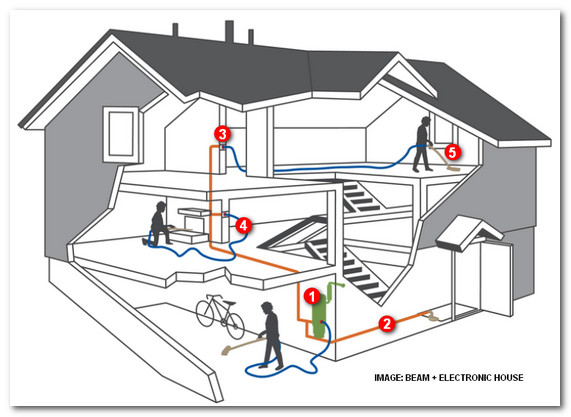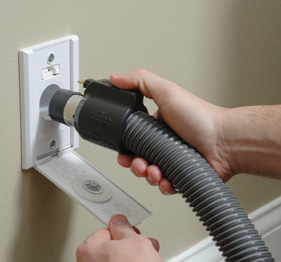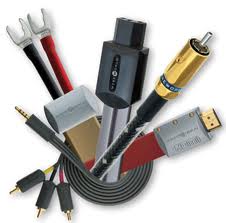
Anatomy of a Central Vacuum System: 5 Easy Pieces
What goes into a central vacuum system? We lay out the five basic pieces: power unit, piping, inlets, hoses and brushes and accessories.
Do you hate dirt and hate to vacuum? A central vacuum system may be just what you need. Instead of lugging a canister around the home, the heavy lifting is done by a power unit located some place like the garage, where it can barely be heard.
A central vacuum system can also be a healthier and greener choice, as it won’t emit dirt particles into the air, as do some other vacuum systems.
For consumers who are new to the category, we provide the foundations of a central vacuum system.

1. Power Unit
Drives the system and is usually mounted in the garage.
Bag vs. cyclonic (bagless) filtering: Bag-type systems require users to replace bags, but don’t require venting the system to the outdoors. Cyclonic units require no messy bags, but do need to be exhausted to the outdoors. Typical homes under 6,000 square feet can run off of a dedicated 20-amp, 120-volt circuit. Larger homes may require a larger, dedicated circuit. AirWatts typically indicate the power of the unit, but be cautious of using single high-air watt motors in larger home applications, as they may wear out too soon. Consider a unit with a utility valve on the tank for cleaning the cars and garage Typically code requires the wall between the garage and home to be penetrated with steel pipe. Check local building codes for safety requirements.
2. Piping
Provides suction from the power unit and delivers waste to the power unit.
2-inch special piping tested to specific standards. Cut the pipe with a miter box, chop saw, or tubing cutter. It must have a smooth, straight cut to reduce potential for debris getting stuck. Use wide sweeping turns at all locations after the inlet valve. For less friction loss, make jogs with 45-degree ells instead of 90-degree ells. Low-voltage wire follows along the outside of the pipe. Strap it to the pipe with zip ties or tape. Wire is run in series rather than home-run.

3. Inlets
Installed in the walls between piping and hoses.
Typically, one inlet covers 600 to 900 square feet of living space. Inlets are located at the same height as electrical outlets, but they can also fit in to the baseboards. Inlets are available as “air-only” or electrified. Electricity is required for traditional power brushes, but can still be provided with a separate cord for non-electrified (less expensive) outlets. Remember to place inlets near outdoor patios and porches. Plan for an inlet near the base of the stairs.
4. Hoses
Connect from the inlet to the vacuum cleaner.
Hoses normally come in 30-foot lengths, but 35-footers are available. Consider buying an additional hose and tool set for upstairs. A hose sock can protect baseboards and furniture. Designate a closet to hang the hose and tool set. Options are available for easy-to-tote spools and for hoses (up to 50 feet) that retract into walls.

5. Power Brushes, Accessories
Connect to hoses for cleaning everything from carpeting to pets.
Power brushes are the best central vac accessory for cleaning carpets and other flooring. Most brushes require electricity, but some lower-powered units can operate via air power. Brushes come in a variety of shapes and sizes for cleaning upholstery, staircases, cars, underneath furniture and more. Additional accessories can be used for cleaning tight spaces, ceiling fans, pets and more.
Grant Olewire of MD Manufacturing contributed to this article.
By CE Pro Editors
http://www.cepro.com/article/anatomy_of_central_vac_systems/T320
Custom Installation Services, LLC – First choice for low voltage wiring and central vac in Charlotte, NC and surrounding areas
Posted in 3D TV, Automation, Central Vac System, Flat Panel TV's, Home Theater, IP Cameras, LED, lighting control, Low Voltage Contractors, Lutron Radio Ra II, Media Rooms, Outdoor Speakers, Structured Wiring, technology
|
Tagged 3d theater in charlotte, Best Buy, boone, business audio video, cable, central vac dealers in charlotte nc, charlotte audio advice, charlotte green electronics company, charlotte hd installers, Charlotte Home Theater, charlotte home theater installation, Charlotte onkyo dealers, comcast, commercial a/v installation charlotte, corporate a/v installation, custom home builders in lake norman, dirt devil, geek squad in charlotte nc, HD installers in Charlotte nc, home theater wiring, innovative systems, Lake Norman, Low voltage contractors, low voltage wiring, Lutron RadioRa2, marantz dealers lake norman, multiroom audio, network, satellite, speakercraft dealers in charlotte nc, sports bar a/v installers, sports bars, sunbrite, surround sound, time warner, tv installation, tv installers charlotte audio video installers, TV recycling, zobo
|
LED vs LCD TVs
How are LED TVs different from LCD TVs?
Simply stated, an LED TV is an LCD TV that is lit with an LED (light emitting diode) light source instead of CCFLs (cold cathode fluorescent lamp). Manufacturers such as Samsung began the trend of marketing the LED-lit LCD TV as an “LED TV” likely in an attempt to easily differentiate the product from typical CCFL lit LCD products.While an LED TV is still technically an LCD TV, just get used to seeing this type of designation. We don’t really have a problem with it and it does, among other things, seem to make it easier to say it out loud.

An LCD TV is comprised of several layers. The front layer is a piece of glass filled with liquid crystals that move and change to produce the images we see on the screen. But images can only be viewed when the screen is illuminated. This requires a light source. The light source is the difference between LED TV and conventional LCD TV.
Here’s a simple explanation of how it works: Conventional LCD TVs use fluorescent tubes (CCFL) to provide light to illuminate the LCD panel and make the images viewable. In an LED TV, the LCD panel is lit from behind with an LED-based backlight. LED lights can be more precisely controlled and can produce richer blacks and a better contrast ratio for a more vivid viewing experience.
Edge Lit vs. Rear Lit
With LED TVs, edge-lit technology is what allows some sets to be less than 1-inch thick. The LEDs are actually arranged around the very edge of the screen, allowing the display to be very thin, since the lighting technology isn’t positioned behind the screen. While this does indeed grant a thinner display, it typically (this is changing now) precludes te manufacturer from setting up a system that optimizes contrast across various areas of the screen.

Smart Dimming and Zones
Several manufacturers are optimizing their LED backlit displays to produce different amounts of backlighting on different areas of the screen. In this way, you can see content that contains bright areas on the screen along with very black areas. Think of a candle lit in a dark room. With your typical edge lit display you have one level for the overall backlight. With Smart Dimming, you can brightly light the part of the screen with teh candle, and then all but turn off the LEDs behind the black areas of the screen.
Should you expect to pay more for LED TV? What are the benefits of LED vs. LCD?
LED TVs like those form Westinghouse Digital are often edge-lit, which means they are generally more energy efficient, weigh less and cost less than full array LED TVs. Some LED TVs are engineered and produced so efficiently that they may even cost less than conventional CCFL lit LCD TVs. The bottom line is that LEDs are getting cheaper and cheaper and soon we estimate they will actually be easier and cheaper to produe than CCFL backlit displays.
LED TVs in general use less energy (and are therefore more efficient and economical to operate) than conventional LCD TVs. LED TVs are also thinner and weigh less than LCD TVs and generally create a brighter picture. For those who are environmentally concerned, LED TVs also contain no Mercury or Lead.
Presented by Westinghouse Digital and edited by Clint DeBoer
http://www.audioholics.com/education/display-formats-technology/led-vs-lcd-tvs
Custom Installation Services, LLC – First choice for low voltage wiring in Charlotte, NC and surrounding areas
Posted in 3D TV, Blu-ray, Flat Panel TV's, Gaming Systems, HDMI Specs, Home Theater, LED, Low Voltage Contractors, Media Rooms, Multi Room A/V, Music and Movies, News, recycling, Structured Wiring
|
Tagged 3d theater in charlotte, audio advice, Best Buy, Blu-ray, central vac dealers in charlotte nc, charlotte audio advice, charlotte custom home builders, connect wii to tv, custom home builders in charlotte nc, geek squad in charlotte nc, HD installers in Charlotte nc, Home theater installers Lake Norman, hook up xbox, innovative systems, LCD TV Installation, LED TV Installation, Low voltage contractors, Marantz, marantz dealers in Charlotte nc, speakercraft dealers in charlotte nc, tv installation, tweeter charlotte, Universal Remote programmers in charlotte nc, zobo
|
The Cabling Industry Needs a Makeover
 It’s time for the cabling industry to reassess how it approaches marketing to consumers. It’s time for the cabling industry to reassess how it approaches marketing to consumers.
I find Twitter entertaining and, at times, almost addicting. This morning a tweet from Production Advice’s Ian Shepherd shocked me with concern for an electronics category that I think is beneficial: cabling.
Shepherd retweeted a blog written by L.A. recording engineer Bobby Owsinski, who blogged about a 2008 Engadget story that asked 12 “audiophiles” to compare an audiophile cable brand with another cabling product. It turns out the other cabling product was a set of coat hangers. The crux of the story is that those audiophiles couldn’t tell the difference between coat hangers and expensive cables.
Adding insult to injury, Owsinski points out the obvious difference between the audiophile community and professional sound engineers that use their listening skills for work by noting, “‘audiophiles’ showed just why they get so much abuse from pros over their so-called “golden ears.”
Monster was the cable manufacturer in question in Engadget’s blind testing, and Owsinski says Monster does make good products; the problem, in his opinion, is with how the products are marketed. “Monster Cable takes some reasonably good cable and markets it in such a way that its perceived value is a lot greater than it deserves to be,” he asserts in his blog. “The problem is that for speaker cable, 12 or 10 gauge zip cord [lamp cable] will work just as well as expensive Monster cable.”
Unfortunately for the cabling industry, Owsinski isn’t alone in his opinion, and websites such as Audioholics.com fuel the public’s disdain for cabling by publishing stories that attack the credibility of many of the cable category’s claims for improved performance.
Like Owsinski, Gene DeSalla at Audioholics points out that Monster and other brands aren’t necessarily bad, its just that their products don’t measure up to the claims.
To rectify this problem, I think it’s time for the cabling category to own up to its self-generated hyperbole and tone it down. Let’s start by addressing the claims of exotic materials, proprietary construction techniques and slick geometry designs that contribute to their out-of-this-world performance claims without any third-party verification.
Manufacturers should look to develop products that are affordable to consumers in these difficult economic times. Too often, critics point to the steep price tags attached to some cabling products and note that a consumer could buy a nice car or place a down payment on a house with the amount of money some companies ask for a pair of speaker cables.
The last thing the cabling industry needs to do is educate the public on the benefits of a properly designed cable that employs quality materials. Owsinski says cabling can make a difference in how a system performs, and I believe he is correct. Using dealers, let’s teach consumers on how to buy cable and how to listen.
One other suggestion I would make is that maybe we should think about locking audiophiles in the basements from which they came. For all their passion about music and equipment, they inflict a lot of irreparable damage to an industry that can hardly afford the scrutiny of a public that doesn’t respect their collective opinions. OK, OK, I’m only kidding about that last suggestion, but I would take away their Diana Krall and Patricia Barber CDs and LPs as punishment for their past transgressions.
By Robert Archer
http://www.cepro.com/article/the_cabling_industry_needs_a_makeover/K536
Custom Installation Services, LLC – ”We may be a few dollars more than the competition, but we are a million times better”.
Posted in 3D TV, APC, Audio Systems, Blu-ray, Gaming Systems, Home Theater, LED, Media Rooms, Multi Room A/V, Structured Wiring, technology
|
Tagged 3d ready preamps, 3d theater in charlotte, apc or panamax, ashville nc strucuted cable, audio advice, audio and video equipment for sport bars, audio video architects charlotte nc, audio video installations charlotte nc, Best Buy, central vac dealers in charlotte nc, central vacuum installation charlotte nc, charlotte custom home builders, charlotte hd installers, Charlotte Home Theater, Charlotte onkyo dealers, Commercial electronics integrators, custom home builders in charlotte nc, custom home charlotte audi video, custom house tv charlotte, custom tv installations charlotte, customhome integration mooresvillenc, geek squad in charlotte nc, home audio consultation and design, Home Theater, innovative systems, speakercraft dealers in charlotte nc, tv installation above fireplace charlotte nc, universal remote service lake norman, whole house audio, zobo
|
|
|
|









